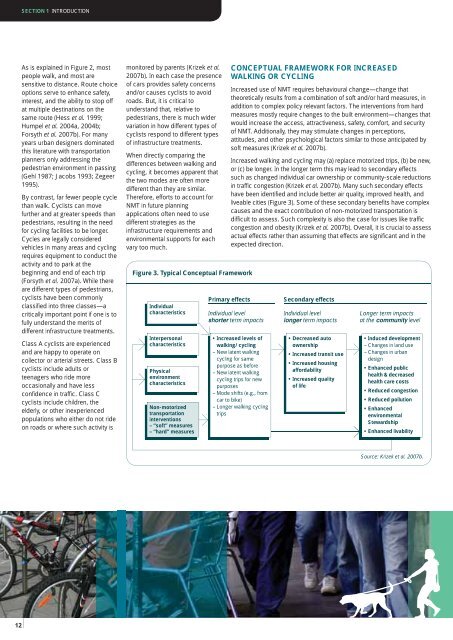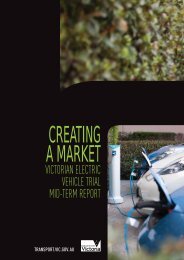Walking and Cycling International Literature Review - Department of ...
Walking and Cycling International Literature Review - Department of ...
Walking and Cycling International Literature Review - Department of ...
You also want an ePaper? Increase the reach of your titles
YUMPU automatically turns print PDFs into web optimized ePapers that Google loves.
SECTION 1 INTRODUCTION<br />
As is explained in Figure 2, most<br />
people walk, <strong>and</strong> most are<br />
sensitive to distance. Route choice<br />
options serve to enhance safety,<br />
interest, <strong>and</strong> the ability to stop <strong>of</strong>f<br />
at multiple destinations on the<br />
same route (Hess et al. 1999;<br />
Humpel et al. 2004a, 2004b;<br />
Forsyth et al. 2007b). For many<br />
years urban designers dominated<br />
this literature with transportation<br />
planners only addressing the<br />
pedestrian environment in passing<br />
(Gehl 1987; Jacobs 1993; Zegeer<br />
1995).<br />
By contrast, far fewer people cycle<br />
than walk. Cyclists can move<br />
further <strong>and</strong> at greater speeds than<br />
pedestrians, resulting in the need<br />
for cycling facilities to be longer.<br />
Cycles are legally considered<br />
vehicles in many areas <strong>and</strong> cycling<br />
requires equipment to conduct the<br />
activity <strong>and</strong> to park at the<br />
beginning <strong>and</strong> end <strong>of</strong> each trip<br />
(Forsyth et al. 2007a). While there<br />
are different types <strong>of</strong> pedestrians,<br />
cyclists have been commonly<br />
classifi ed into three classes—a<br />
critically important point if one is to<br />
fully underst<strong>and</strong> the merits <strong>of</strong><br />
different infrastructure treatments.<br />
Class A cyclists are experienced<br />
<strong>and</strong> are happy to operate on<br />
collector or arterial streets. Class B<br />
cyclists include adults or<br />
teenagers who ride more<br />
occasionally <strong>and</strong> have less<br />
confi dence in traffi c. Class C<br />
cyclists include children, the<br />
elderly, or other inexperienced<br />
populations who either do not ride<br />
on roads or where such activity is<br />
monitored by parents (Krizek et al.<br />
2007b). In each case the presence<br />
<strong>of</strong> cars provides safety concerns<br />
<strong>and</strong>/or causes cyclists to avoid<br />
roads. But, it is critical to<br />
underst<strong>and</strong> that, relative to<br />
pedestrians, there is much wider<br />
variation in how different types <strong>of</strong><br />
cyclists respond to different types<br />
<strong>of</strong> infrastructure treatments.<br />
When directly comparing the<br />
differences between walking <strong>and</strong><br />
cycling, it becomes apparent that<br />
the two modes are <strong>of</strong>ten more<br />
different than they are similar.<br />
Therefore, efforts to account for<br />
NMT in future planning<br />
applications <strong>of</strong>ten need to use<br />
different strategies as the<br />
infrastructure requirements <strong>and</strong><br />
environmental supports for each<br />
vary too much.<br />
Figure 3. Typical Conceptual Framework<br />
Individual<br />
characteristics<br />
Interpersonal<br />
characteristics<br />
Physical<br />
environment<br />
characteristics<br />
Non-motorized<br />
transportation<br />
interventions<br />
– “s<strong>of</strong>t” measures<br />
– “hard” measures<br />
Primary effects<br />
CONCEPTUAL FRAMEWORK FOR INCREASED<br />
WALKING OR CYCLING<br />
Increased use <strong>of</strong> NMT requires behavioural change—change that<br />
theoretically results from a combination <strong>of</strong> s<strong>of</strong>t <strong>and</strong>/or hard measures, in<br />
addition to complex policy relevant factors. The interventions from hard<br />
measures mostly require changes to the built environment—changes that<br />
would increase the access, attractiveness, safety, comfort, <strong>and</strong> security<br />
<strong>of</strong> NMT. Additionally, they may stimulate changes in perceptions,<br />
attitudes, <strong>and</strong> other psychological factors similar to those anticipated by<br />
s<strong>of</strong>t measures (Krizek et al. 2007b).<br />
Increased walking <strong>and</strong> cycling may (a) replace motorized trips, (b) be new,<br />
or (c) be longer. In the longer term this may lead to secondary effects<br />
such as changed individual car ownership or community-scale reductions<br />
in traffi c congestion (Krizek et al. 2007b). Many such secondary effects<br />
have been identifi ed <strong>and</strong> include better air quality, improved health, <strong>and</strong><br />
liveable cities (Figure 3). Some <strong>of</strong> these secondary benefi ts have complex<br />
causes <strong>and</strong> the exact contribution <strong>of</strong> non-motorized transportation is<br />
diffi cult to assess. Such complexity is also the case for issues like traffi c<br />
congestion <strong>and</strong> obesity (Krizek et al. 2007b). Overall, it is crucial to assess<br />
actual effects rather than assuming that effects are signifi cant <strong>and</strong> in the<br />
expected direction.<br />
Individual level<br />
shorter term impacts<br />
• Increased levels <strong>of</strong><br />
walking/ cycling<br />
– New latent walking<br />
cycling for same<br />
purpose as before<br />
– New latent walking<br />
cycling trips for new<br />
purposes<br />
– Mode shifts (e.g., from<br />
car to bike)<br />
– Longer walking cycling<br />
trips<br />
Secondary effects<br />
Individual level<br />
longer term impacts<br />
• Decreased auto<br />
ownership<br />
• Increased transit use<br />
• Increased housing<br />
affordability<br />
• Increased quality<br />
<strong>of</strong> life<br />
Longer term impacts<br />
at the community level<br />
• Induced development<br />
– Changes in l<strong>and</strong> use<br />
– Changes in urban<br />
design<br />
• Enhanced public<br />
health & decreased<br />
health care costs<br />
• Reduced congestion<br />
• Reduced pollution<br />
• Enhanced<br />
environmental<br />
Stewardship<br />
• Enhanced livability<br />
Source: Krizek et al. 2007b.<br />
12

















